The James Webb Space Telescope released its first science images today. Here’s what these images show us.
What would you aim your shiny new telescope at, if you could? With five hand-picked targets for the James Webb Space Telescope, NASA has wowed the collective minds of the astronomical community with the release of the observatory's first science images.
Webb is pushing back the frontiers of astronomy by looking further and fainter in time and space than ever before. It will witness the formation of galaxies in the early universe, including light from the very first stars; explore exoplanet compositions; and even track comets closer to home. The first five images shown here are just the start of the first year's worth of observations, selected in a competitive process, and there are many more to come.
Webb's First Images
On July 6th, the team released an amazing teaser image of the field surrounding the 9.3-magnitude star 2MASS 16235798+2826079, courtesy of the telescope’s Fine Guidance Sensor (FGS), revealing a menagerie of galaxies. For a very short time, the image was among the deepest ever taken.
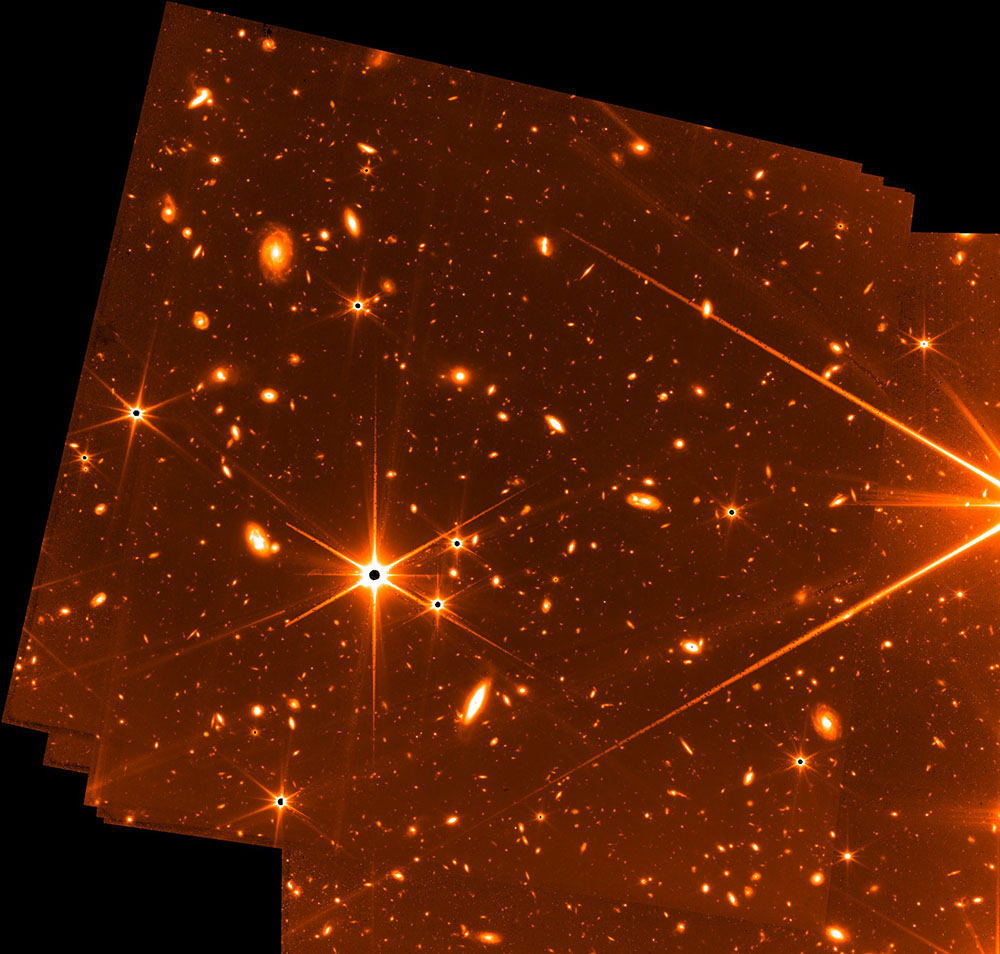
NASA / CSA / FGS team
The Deep Field
Days later, on July 12th, the Webb team dropped the first science image at a White House press conference, showing off the gravitationally lensing galaxy group SMACS 0723, captured by the Near-Infrared Camera (NIRCam) over a mere 12.5-hour exposure.
Located in the southern constellation of Volans, this galaxy cluster existed 4.6 billion years ago (an appreciable fraction of the universe's life span), while the lensed galaxies behind are farther still. The galaxies in the cluster are generally white, while the more galaxies appear red and distorted, due to the cluster's gravitational distortion of their light.
Among the background galaxies identified so far is a galaxy at a redshift of 13.1, which means we're seeing a galaxy that existed just 330 million years after the Big Bang!
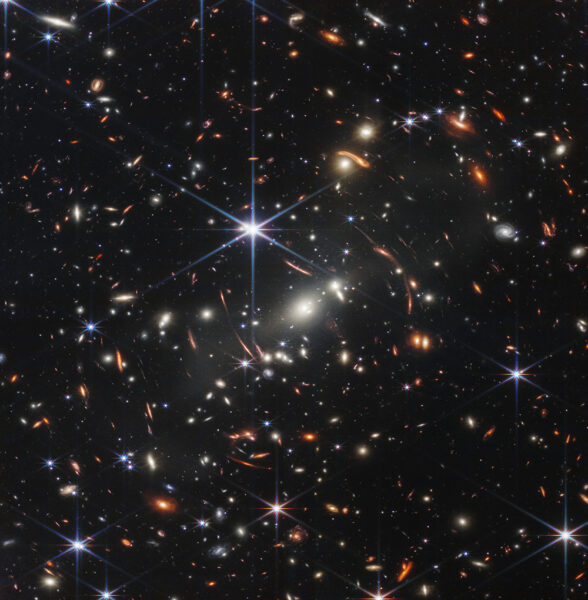
NASA / ESA / CSA / STScI
The Exoplanet
A day later, on July 12th, the team revealed four additional images that brought the presenting astronomers to tears.
WASP-96b is a hot gas giant 1,150 light-years away, circling its star in a tight, 3.4-day orbit. The planet's proximity to its star is probably why it's a "super-puff," with the size of Jupiter but only half its mass.
Webb turned its Near-Infrared Imager and Slitless Spectrograph (NIRISS) on the distant world during a 6.4-hour transit, recording the star's light that passed through the sliver of atmosphere visible as the planet traveled across the face of its star. The resulting spectrum, spanning 0.6 to 2.8 microns, shows the first signs of water vapor in this planet's atmosphere, as well as signatures of clouds and haze. The clouds in particular are a surprise, as previous ground-based observations had found no sign of them.
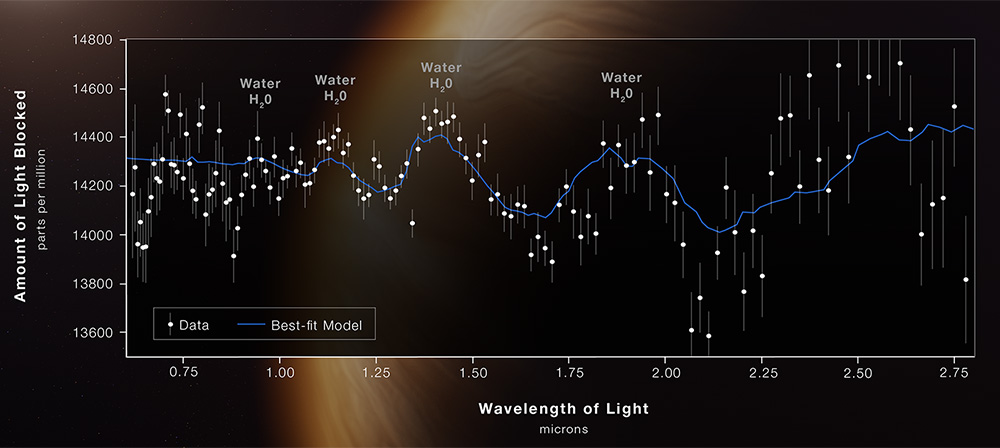
NASA/ESA/CSA/STScI
The Planetary Nebula
The Southern Ring Nebula, also known as the Eight-burst Nebula or NGC 3132, is 2,000 light-years away in the constellation Vela.
A star at the center of this beauty is the one creating it, by sending out multiple waves of gas and dust as it ejects its outer layers. But the star responsible is not the oneseen in the near-infrared image at left, below. It's the image taken by the Mid-Infrared Instrument (MIRI) (on the right, below) that for the first time reveals the second, dimmer star that's dying in the nebula's core.
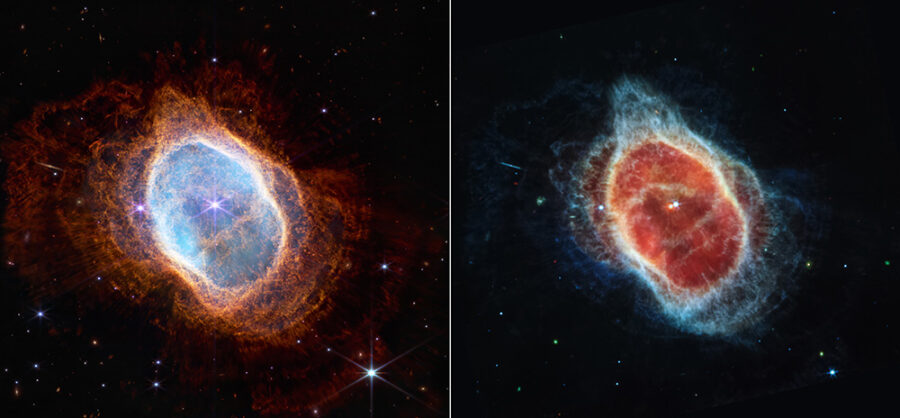
NASA / CSA / ESA / STScI
The brighter star is at an earlier stage of evolution and will one day send out its own planetary nebula. For now, its heat and radiation stirs the pot of gas, creating beautiful patterns.
The tiny spike that appears to be embedded in the nebula (on the left in both images) turned out to be an edge-on background galaxy shinning through the haze.
The Galaxy Group
Stephan’s Quintet: The iconic backyard-astronomer's target has never looked better than in this infrared view. The cluster represents the first compact galaxy group known, discovered in 1877 by astronomer Édouard Stephan. Located in the constellation Pegasus (the only northern hemisphere target in today's release), Stephan's Quintet consists of four galaxies locked in a tight gravitational embrace, 290 million light-years away. (NGC 7320, the leftmost galaxy is a good deal closer, at only 40 million light-years.)
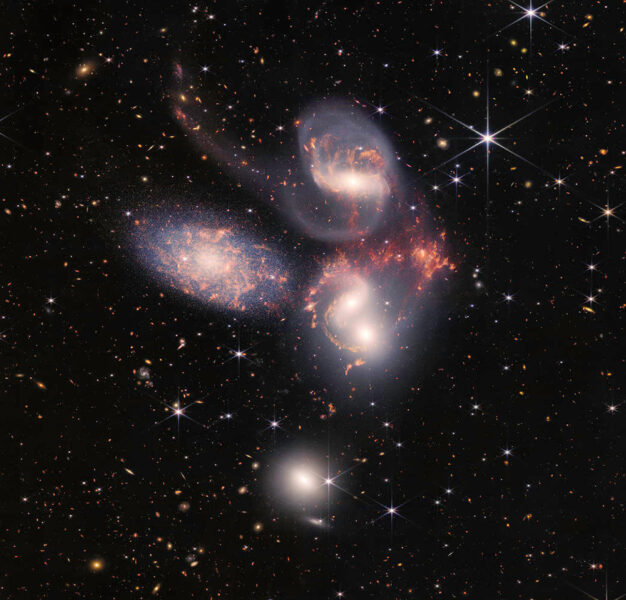
NASA / CSA / ESA / STScI
In addition to the image, which reveals swirls of dust, gas, and stars swept out in gravitational interactions, astronomers also took spectra of the galactic cores. The topmost galaxy, NGC 7319, contains a gas-guzzling black hole that the data show fuels terrific winds — these had remained hidden behind obscuring dust clouds until now.
The Star-Forming Cloud
The Carina Nebula: Located 7,600 light-years away in the southern constellation Carina, the Carina Nebula is a massive star-forming complex. Webb's view shows the edge of a star-forming region within the nebula. Hot, massive stars at the center of this region emit winds and intense radiation that sculpt the surrounding dust into "cosmic cliffs." That push, in turn, instigates new rounds of star formation. The tallest peaks of eroding dust in the image below are seven light-years high.
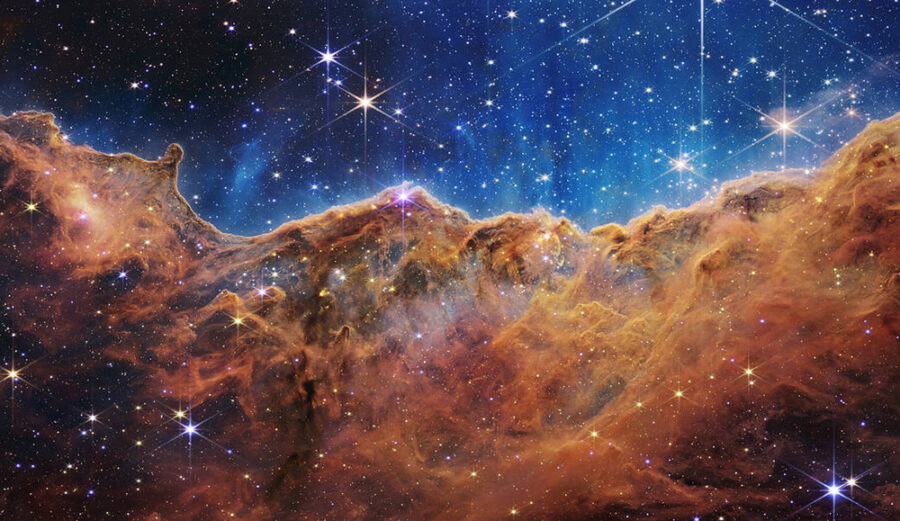
NASA / ESA / CSA / STScI
Webb's longer wavelengths reveal newborn stars and other details that have remained hidden behind dust until now. You can see the youngest proto-stars as red dots in the dark, dusty region of the cloud.
“These images were chosen to illustrate the exquisite sensitivity and imaging capability of JWST,” Hammel says. “If you’ve been wowed by Hubble images, then hang on to your hat — these first science observations are just the appetizer, the main course is yet to come!”
And as a neat sort of "Easter egg," an image of Jupiter and its moons turned up in the JWST commissioning report, courtesy of NIRCam:
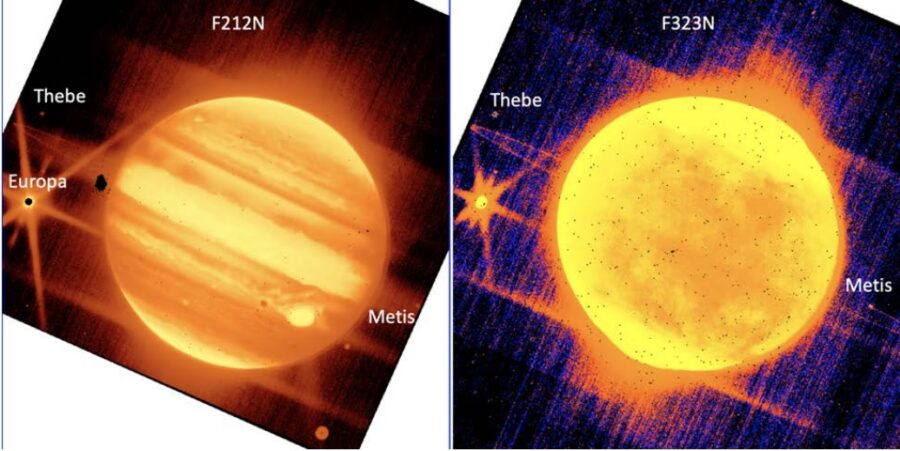
NASA / ESA / CSA / STScI
The images show that Webb can track moving objects, even near a dazzling target such as Jupiter, something that will come in handy for observing comets and other solar system objects.
From There to Here
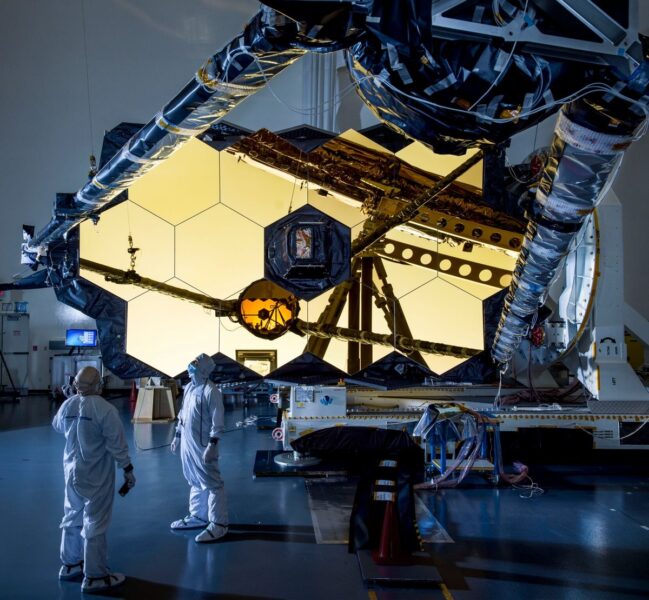
NASA/JWST
This release marks the official start of science operations for JWST. Built and operated in partnership with NASA, the Canadian Space Agency and the European Space Agency, JWST launched on Christmas Day 2021. JWST now circles the distant L2 Lagrange point, one million miles out opposite to the Sun. At this location, and with its multi-layered sunshield, the telescope stays as cool as possible, below the 50 kelvin limit necessary for infrared observations.
The journey to this orbit, the unfurling of the origami spacecraft, and the alignment and calibration of the mirrors and instruments is why it took six months from launch to begin science operations.
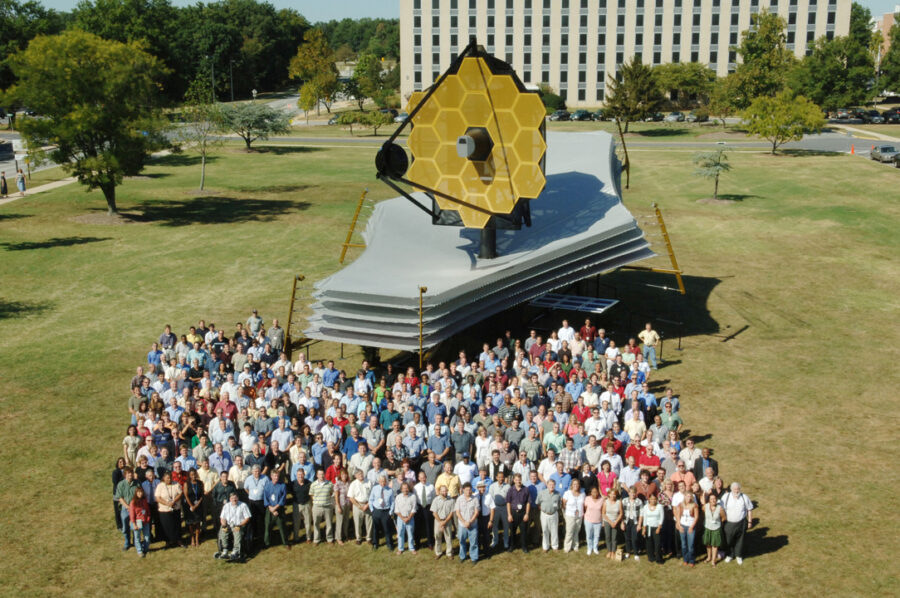
NASA
NIRSpec (the Near-Infrared Spectrograph) was the last instrument to complete calibration on July 7th. Other instruments onboard include the Near Infrared Camera (NIRCAM), the Mid-Infrared Instrument (MIRI), and the Fine Guidance Sensor/Near Infrared Imager and Slitless Spectrograph (FGS/NIRISS).
“The telescope and instrument commissioning actually went right on schedule!” says Heidi Hammel (NASA/GSFC) “This is a very sophisticated telescope, with a complex suite of instruments that have many operational modes, all of which needed to be carefully checked and verified.”
The long road to operations wasn’t without its bumps: JWST sustained six micrometeoroid strikes within its first six months, a rate that engineers had predicted; however, one in late May packed more of a wallop than expected. Micrometeoroids add some uncertainty to the mission length, but the exception launch accuracy and other factors led to a welcome excess of fuel: Estimates released today suggest the mission could last more than 20 years.
It’s been a decades-long road from conception, to design, to launchpad and commissioning, but the James Webb Space Telescope is ready to get down to work, pushing back the boundaries of astronomy for a new generation.
 4
4









Comments
Rod
July 12, 2022 at 4:21 pm
Good report and water vapor found at WASP-96 b hot jupiter.
My observation. Specific properties for WASP-96 b are found at http://exoplanet.eu/catalog/wasp-96_b/
Using the properties at this site I calculate P = 3.4199E+00 days, site reports 3.4252602 day period. P = 3.4199. In 1 Gyr this hot jupiter could complete 1.0680E+11 or 106.80 billion revolutions around the host star (a check I apply to exoplanet reports and their ages presented for the stars). Given mass and radius listed, mean density = 0.34457 g cm^-3. The NASA exoplanet site shows distance is 352.464 pc, https://exoplanetarchive.ipac.caltech.edu/overview/WASP-96%20b#planet_WASP-96-b_collapsible%5D
You must be logged in to post a comment.
Anthony Barreiro
July 12, 2022 at 5:53 pm
Truly a historic accomplishment.
Along with the images, the spectroscopy is amazing. Here's a press release about the spectroscopy of SMACS 0723, with spectrograms of four of the gravitationally lensed background galaxies.
https://webbtelescope.org/contents/media/images/2022/035/01G7HRYVGM1TKW556NVJ1BHPDZ
"Light from the farthest galaxy shown traveled 13.1 billion years before Webb’s mirrors captured it. These observations mark the first time these particular emission lines have been seen at such immense distances – and these are only Webb’s initial observations. There may be even more distant galaxies in this image!"
You must be logged in to post a comment.
Matt
July 16, 2022 at 6:12 am
Many of us wondered if Webb could unfold properly and do its stuff. How wonderful that it has!
You must be logged in to post a comment.
Willeau
July 19, 2022 at 9:31 am
I truly love these images. JWST is on its way to turning what we know about the universe on its head. Am I seeing a sixth galaxy in the image of Stephan's Quintet? That sure looks like a small galaxy sitting just under the galaxy at the bottom of the image. These are incredible images. I can't wait for some of my favorite targets to be re-imaged by JWST!!!
You must be logged in to post a comment.
You must be logged in to post a comment.